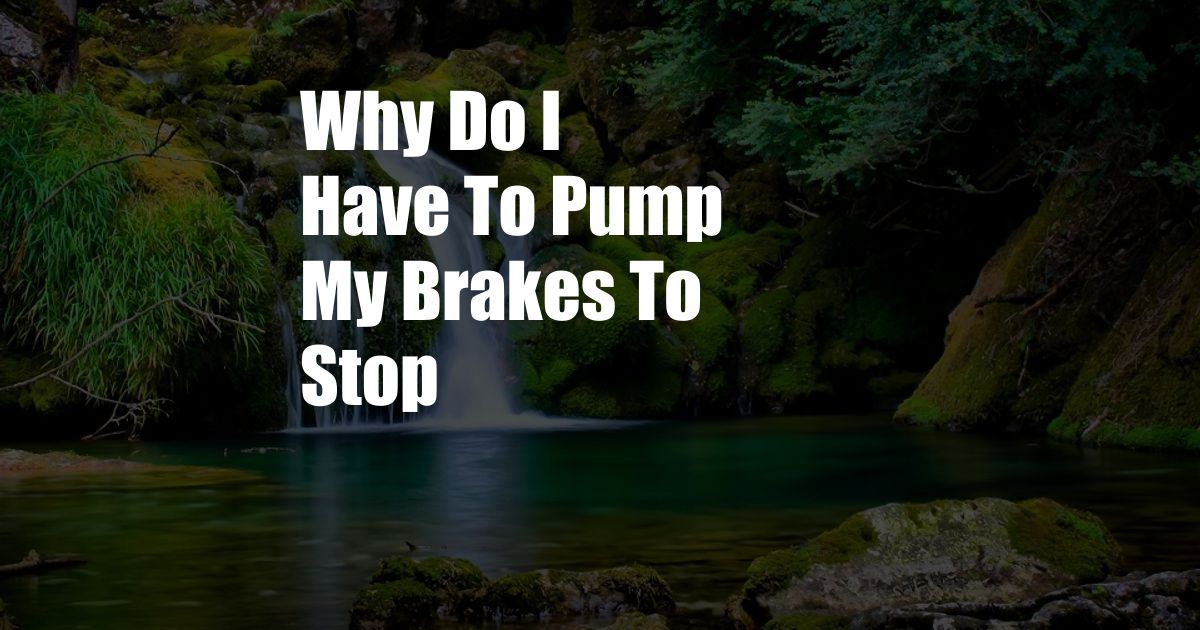
Why Do I Have to Pump My Brakes to Stop?
Have you ever been driving down a busy road or highway, when suddenly the car in front of you brakes hard? Your first instinct is to hit your brakes hard as well, but then you suddenly feel that your car is starting to swerve. You quickly let up on the brakes, but it’s too late – you’ve lost control of your car and you crash into the car in front of you.
This is a scenario that happens all too often on our roads, and many of them are caused by drivers who don’t know how to brake properly. The truth is, pumping your brakes when you need to stop can be dangerous, and can often lead to accidents.
When to Pump Your Brakes
You should never pump your brakes unless you’re driving on a slick surface, such as snow or ice. On these surfaces, it’s possible to lose traction if you brake too hard, which can cause your car to skid. In these cases, it’s best to pump your brakes gently, which will help to prevent you from losing control of your car.
On dry surfaces, however, you should never pump your brakes. Instead, you should apply firm and steady pressure to the brake pedal. This will help to bring your car to a stop as quickly as possible, without losing control of your car.
How to Brake Properly
To brake properly on a dry surface, follow these steps:
- Apply firm but steady pressure to the brake pedal.
- Keep your eyes focused on the road ahead.
- Steer the car in a straight line.
- If you need to stop quickly, you can increase the pressure on the brake pedal, but be careful not to lock up your brakes.
- If you feel your car starting to skid, let up on the brake pedal and steer the car in the direction you want to go.
It’s important to practice braking in a safe environment, such as an empty parking lot, so that you can get a feel for how your car responds to different braking techniques.
The Latest Trends and Developments in Braking Technology
There are a number of new braking technologies that are being developed, which can help to improve the safety and performance of brakes. These technologies include:
- Anti-lock brakes prevent the wheels from locking up, which can help to prevent skids.
- Traction control systems help to keep the tires from spinning, which can also help to prevent skids.
- Electronic stability control systems help to prevent the car from rolling over.
These technologies are becoming increasingly common on new cars, which helps to make driving safer for everyone.
Tips and Expert Advice for Braking Effectively
Here are some tips and expert advice for braking effectively:
- Anticipate stops. The sooner you start to brake, the more time you’ll have to come to a stop safely
- Brake smoothly. Don’t slam on the brakes, which can cause your car to skid.
- Brake in a straight line. Don’t brake hard while turning, as this can cause the car to roll over.
- If you feel your car starting to skid, let up on the brake pedal and steer the car in the direction you want to go.
- Practice braking in a safe environment. This will help you to get a feel for how your car responds to different braking techniques
FAQ
Q: Why do I have to pump my brakes on ice?
A: You should only pump your brakes on ice or other slick surfaces. Pumping your brakes on dry surfaces can cause you to lose control of your car.
Q: What is the best way to brake in a straight line?
A: To brake in a straight line, apply firm but steady pressure to the brake pedal, keep your eyes focused on the road ahead, and steer the car in a straight line.
Q: What should I do if I feel my car starting to skid?
A: If you feel your car starting to skid, let up on the brake pedal and steer the car in the direction you want to go.
Conclusion
Knowing how to brake properly is an important part of being a safe driver. By following these tips and advice, you can help to ensure that you and your passengers stay safe on the road.
Are you interested in learning more about braking and other driving safety tips? If so, be sure to check out our other blog posts on this topic!